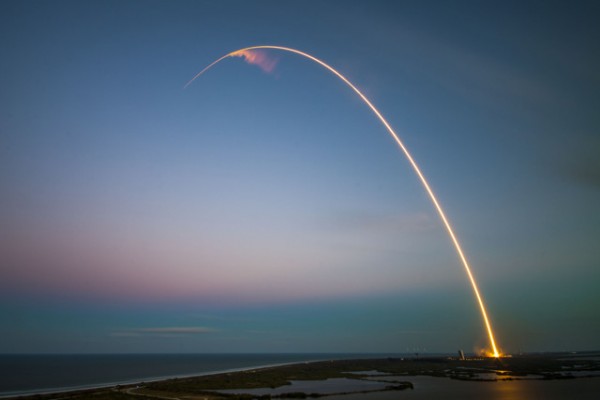By Ana Verayo, | March 29, 2017

SES-9 spacecraft now in Geostationary Transfer Orbit, 40,600 km in altitude.
SpaceX conducted a crucial rocket engine burn test that will be used for the launch of an SES communications satellite tomorrow, March 30, Thursday. What makes this launch a very crucial one for SpaceX and the spaceflight industry is that this marks the first ever launch to use a reusable Falcon 9 first stage rocket, that has been flown before.
Like Us on Facebook
SpaceX founder and CEO Elon Musk believes that the key to slashing space launch costs is reusable rockets. A "used" Falcon 9 booster rocket and its nine engines were briefly fired on Monday. This short "hot fire" test is also a routine pre-flight procedure for SpaceX in order to confirm that the rocket is ready for the launch.
At 2 P.M. EDT Monday, nine Merlin 1D engines blasted to life and shut down immediately after three seconds. This successful engine fire test left a large white pillar of cloud from the exhaust that raged over the NASA Kennedy Space Center Monday afternoon, that also quickly disappeared.
After a successful engine fire test, it can also be assumed that telemetry analysis can now confirm good performance of the reusable Falcon 9 booster rocket. Weather permitting also, SpaceX should go on as scheduled with the launch on Thursday at around 6 P.M.
Thursday's launch will place an SES-10 satellite into orbit which is developed and built by Airbus Defense and Space. This satellite mission aims to provide direct to home television services and high speed data connections in Latin America and the Caribbean regions.
According to chief technology officer Martin Halliwell of SES, when SpaceX became the first commercial satellite operator in 2013, we were still excited as a first customer up until now, for being able to be part of SpaceX's first ever mission using a reusable rocket. Halliwell adds, we believe that reusable rockets will revolutionize spaceflight and will be able to make access to space more efficient in costs and management.
Tomorrow's launch will be the fourth launch for SpaceX after launching 10 Iridium NEXT satellites last January from the Vandenberg Air Force Base in California, a cargo resupply mission to the International Space Station last February, and more recently, the launch of an EchoStar communications satellite a few weeks ago from NASA's Kennedy Space Center.
To date, eight reusable rockets successfully returned to Earth after space launches, out of 13. Five of those rockets landed on a droneship off the coast of Florida and three returned to the Cape Canaveral Air Force Station.
This reusable rocket that will be used for tomorrow's SES-10 mission was first used last April 2016 that helped boost a SpaceX cargo supply vehicle into lower Earth orbit, to deliver food and supplies to the ISS. This also marked SpaceX's second successful vertical reusable booster rocket landing on a droneship.
-
Use of Coronavirus Pandemic Drones Raises Privacy Concerns: Drones Spread Fear, Local Officials Say

-
Coronavirus Hampers The Delivery Of Lockheed Martin F-35 Stealth Fighters For 2020

-
Instagram Speeds Up Plans to Add Account Memorialization Feature Due to COVID-19 Deaths

-
NASA: Perseverance Plans to Bring 'Mars Rock' to Earth in 2031

-
600 Dead And 3,000 In The Hospital as Iranians Believed Drinking High-Concentrations of Alcohol Can Cure The Coronavirus

-
600 Dead And 3,000 In The Hospital as Iranians Believed Drinking High-Concentrations of Alcohol Can Cure The Coronavirus

-
COVID-19: Doctors, Nurses Use Virtual Reality to Learn New Skills in Treating Coronavirus Patients







